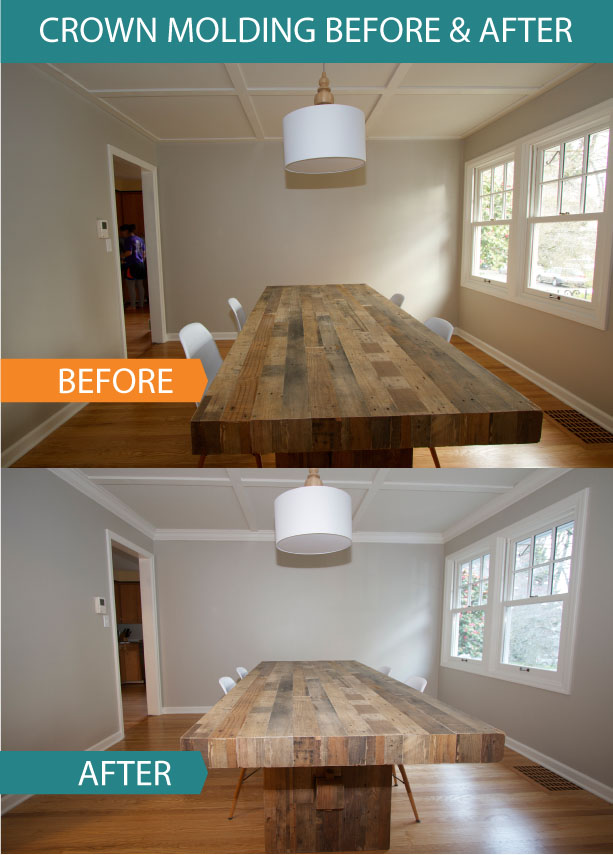I have a confession to make. I am not a carpenter. Up until a few weeks ago, I had never used a miter saw (or a table saw for that matter) and I had certainly never used any power tools other than the occasional power drill. As a serial renter (eight rentals in ten years!) I never really had the ability to renovate and I moved so frequently, it hardly seemed worth the time to hang up our artwork or photos. I don’t have an incredibly crafty husband, I don’t have very many tools and I pretty much google my way through projects.
Here is the good news for you: because I am learning this all as I go, I sift through all of the tutorials, make all the mistakes myself and can explain a method that any beginner (like myself) can accomplish.
As I mentioned here, I love coffered ceilings and really wanted to add some interest to my dining room ceiling. The first problem is my ceilings are only 8′ high and the second problem is that building a true coffered ceiling looks incredibly difficult. Enter the faux coffered ceiling. This project will give you the shadows and look of a coffered ceiling without bringing down so much depth and is pretty simple to execute.

Here is a before & after of the project:
If you could use a little coffering in your life, here is how I did it:
The first step is to measure the dimensions of your room. Then take four boards and cut them to the length of your walls with the end at a 45° angle. Mark the edges of your ceiling for studs (using a stud finder) and fasten the boards to the ceiling where you marked for studs. If you have a nail gun, this part will be a cinch. If you don’t, you can pre-drill small holes where the board lines up with the studs and nail the board to the ceiling with a hammer (that’s what I did).
It makes good sense to label the boards as you are cutting them and measuring them so they don’t get mixed up. Here is how they will go together:
Once you have the “frame” up you can begin to work on the inner pieces. You should measure the dimensions of the ceiling “inside” the frame.
I decided to have two beams running in each direction, dividing my ceiling up into nine squares.
I drew up a diagram and numbered the pieces. It ended up looking like this:
Now my first thought was to divide the inside measurement by three and get to cutting my pieces, but I forgot one little detail. Apparently, there are wood beams (joists) running across the ceiling and you have to find them and attach the beams to those.
Using a stud finder, locate which way your beams are running and mark where the joists on your ceiling are.
When I located mine, they were here:
Now for the blue pieces, that run across the joists, you can space them out evenly because you just need to attach them where they meet the joists.
My measurements broke down like this:
For the yellow pieces, I had to space them where there was a joist available. At first I was really worried about this, but it ended up looking really even, even though it was a few inches off from perfectly even. Those measurements broke down like this:
I cut the pieces using a miter saw (first time using one) and it was pretty easy! The most important part was marking the center on the board so that the point (where four boards intersect) had a tight fit. Make a careful and accurate line down the middle of the board, as pictured below. Then make two lines at opposite 45° angles that intersect the center line. Then measure from the tip of the point to the end of the board and make a straight cut to match your measurements from the above images.
Start attaching your boards from one corner and work your way outward. I started with pieces 6 & 12. I also drew lines on my ceiling for where the center of the boards should be so that when I held up the board I could align the tip of the point with the line. Once we got started it ended up moving very quickly and was a LOT easier than the crown molding project we are working on now!
The crown molding has taken us days to get right, but I finally think we found the right “tricks” to make it work. I’ll update you next week on my frustration-free tips to crown molding installation. (I’ve already dealt with all the frustration for you!)
Have a great weekend!
